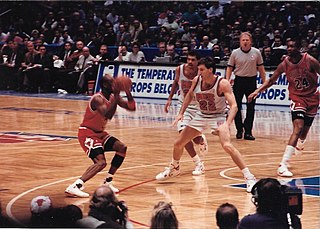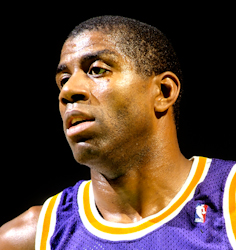Related Research Articles

Basketball is a team sport in which two teams, most commonly of five players each, opposing one another on a rectangular court, compete with the primary objective of shooting a basketball through the defender's hoop, while preventing the opposing team from shooting through their own hoop. A field goal is worth two points, unless made from behind the three-point line, when it is worth three. After a foul, timed play stops and the player fouled or designated to shoot a technical foul is given one, two or three one-point free throws. The team with the most points at the end of the game wins, but if regulation play expires with the score tied, an additional period of play (overtime) is mandated.

The point guard (PG), also called the one or the point, is one of the five positions in a regulation basketball game. A point guard has perhaps the most specialized role of any position and is usually the shortest player on the court. Point guards are expected to run the team's offense by controlling the ball and making sure that it gets to the right player at the right time. Above all, the point guard must understand and accept their coach's game plan; in this way, the position can be compared to the position of quarterback in gridiron football. They must also be able to adapt to what the defense is allowing and must control the pace of the game.
The triangle offense is an offensive strategy used in basketball. Its basic ideas were initially established by Hall of Fame coach Sam Barry at the University of Southern California. His system was further developed by former Houston Rockets and Kansas State University basketball head coach Tex Winter, who played for Barry in the late 1940s. Winter later served as an assistant coach for the Chicago Bulls in the 1980s and 1990s and for the Los Angeles Lakers in the 2000s, mostly under head coach Phil Jackson.

John Vincent Calipari is an American basketball coach who is the head coach at the University of Arkansas. He was the head coach at the University of Kentucky from 2009 until the end of the 2023–2024 season, which he led to one NCAA National Championship in 2012. He has been named Naismith College Coach of the Year three times, and was inducted into the Basketball Hall of Fame in 2015.
The Princeton offense is an offensive basketball strategy which emphasizes constant motion, back-door cuts, picks on and off the ball, and disciplined teamwork. It was used and perfected at Princeton University by Pete Carril, though its roots may be traced back to Franklin “Cappy” Cappon, who coached Princeton in the late 1930s, and Bernard "Red" Sarachek, who coached at Yeshiva University from 1938 to 1977.

In basketball, there are five players on court per team, each assigned to positions. Historically, these players have been assigned to positions defined by the role they play on the court, from a strategic point of view. The three main positions are guard, forward, and center, with the standard team featuring two guards, two forwards, and a center. Over time, as more specialized roles developed, each of the guards and forwards came to be differentiated, and today each of the five positions is known by a unique name and number: point guard (PG) or 1, the shooting guard (SG) or 2, the small forward (SF) or 3, the power forward (PF) or 4, and the center (C) or 5 "post position".
Basketball moves are generally individual actions used by players in basketball to pass by defenders to gain access to the basket or to get a pass to a teammate to score.

Ramon Sadaya Fernandez is a Filipino former professional basketball player and current commissioner of the Philippine Sports Commission. Fernandez won four PBA Most Valuable Player awards and a record of 19 PBA titles. Fernandez stood at 6'4 barefoot during his prime but due to mild gigantism, he grew to 6'5 during his final seasons. He scored 18,996 points to finish as the PBA's all-time scoring leader. He is also the PBA's all-time leader in rebounds, blocked shots, and free throws made, playing minutes and second all-time in assists, games played and steals. He played for five teams in his entire PBA career starting with the Toyota, Manila Beer, Tanduay, Purefoods and San Miguel. Fernandez played in multiple International Tournaments as a member of the Philippine basketball team. He is regarded as one the greatest players to have ever played in the Philippine Basketball Association with tenured analysts and former (retired) players who had the chance to play with and against him citing him as arguably the greatest ever.

This glossary of basketball terms is a list of definitions of terms used in the game of basketball. Like any other major sport, basketball features its own extensive vocabulary of unique words and phrases used by players, coaches, sports journalists, commentators, and fans.

A layup in basketball is a two-point shot attempt made by leaping from below, laying the ball up near the basket, and using one hand to bounce it off the backboard and into the basket. The motion and one-handed reach distinguish it from a jump shot. The layup is considered the most basic shot in basketball. When doing a layup, the player lifts the outside foot, or the foot away from the basket.
The Flex offense is an offensive strategy in basketball invented in 1967 by Rene Herrerias while coaching at Cal-Berkeley. It was utilized to bring UCLA's star center, Lew Alcindor, away from the basketball. The offense was originally called the "Cha Cha". It is a patterned offense relying on cuts across the key and down screens to create a "pick-the-picker" action. This offense is most effective against a man-to-man defense, though some ambitious coaches have used it against odd front zones. It is the favored offense of many high school programs because it requires players to be in constant motion and the patterns of screens and cuts are easy to remember. Though dismissed by many coaches at the college level for its predictability, some notable programs still rely on it. It has been run by many NCAA teams, including by Gary Williams of the University of Maryland. Williams used the flex offense to lead the Terrapins to the 2002 NCAA National Championship. Also, Gordie James of Willamette University used the flex offense to lead the Bearcats to the 1993 NAIA Division II National Championship. Additionally, Jerry Sloan ran his variation of it for years with the Utah Jazz.

The 1981 NCAA Division I basketball tournament involved 48 schools playing in single-elimination play to determine the national champion of men's NCAA Division I college basketball. It began on March 12, 1981, and ended with the championship game on March 30 in Philadelphia. A total of 48 games were played, including a national third-place game. It was also the last tournament to be televised on NBC, before CBS took over the following year. Additionally, it was the last season in which the NCAA sponsored championships only in men's sports; the first Division I women's tournament would be played the following year.
Basketball coaching is the act of directing and strategizing the behavior of a basketball team or individual basketball player. Basketball coaching typically encompasses the improvement of individual and team offensive and defensive skills, as well as overall physical conditioning. Coaches also have the responsibility to improve their team by player development, strategy, and in-game management. Coaches also teach and inspire their team to be their best.

Vance Patrick Walberg is an American basketball coach who is the head coach of the Fresno State Bulldogs of the Mountain West Conference. He was previously an assistant coach for the Sacramento Kings of the National Basketball Association (NBA), the head men's basketball coach at Pepperdine University, and an assistant coach at the University of Massachusetts. He is known for developing the dribble drive motion offense, sometimes known as the Memphis Attack, AASAA offense.

The 1–3–1 defense and offense is a popular strategy used in basketball.

The 2–3 zone defense is a defensive strategy used in basketball as an alternative to man-to-man defense. It is referred to as the 2–3 because of its formation on the court, which consists of two players at the front of the defense and three players behind.
The amoeba defense is a defensive strategy in the game of basketball.
Basketball is a ball game and team sport in which two teams of five players try to score points by throwing or "shooting" a ball through the top of a basketball hoop while following a set of rules. Since being developed by James Naismith as a non-contact game that almost anyone can play, basketball has undergone many different rule variations, eventually evolving into the NBA-style game known today. Basketball is one of the most popular and widely viewed sports in the world.
Basketball is a team sport in which two teams of five players try to score points by throwing or "shooting" a ball through the top of a basketball hoop while following a set of rules. Basketball is one of the most popular and widely viewed sports in the world.
Wheel offense is an offensive strategy in basketball, developed in the late 1950s by Garland F. Pinholster at the Oglethorpe University. It is a kind of continuity offense in which players move around in a circular pattern to create good scoring opportunities. The wheel offense is a popular offensive play, frequently used by teams from middle school to college levels because it can effectively work against any defense, including zone defense and man-to-man defense.
References
- ↑ Katz, Andy (2007-09-19). "Calipari committed to turning Memphis into legit contender".
- ↑ DeCourcy, Mike (2007-08-20). "Pepperdine's offense is a recruiting tool, too". Archived from the original on 2007-12-25.
- 1 2 3 4 5 6 Wahl, Grant (2008-02-18). "Fast and Furious". Sports Illustrated . Vol. 108, no. 7. Time Inc. pp. 49–56. Archived from the original on February 18, 2008. Retrieved 2008-02-18.
- 1 2 DeCourcy, Mike (2008-01-18). "Breaking down Memphis' dribble-drive motion". The Sporting News. NBC Universal. Archived from the original on 2008-10-10. Retrieved 2008-02-18.
